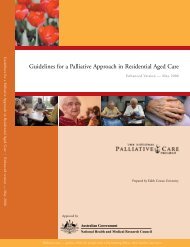The hardest thing we have ever done - Palliative Care Australia
The hardest thing we have ever done - Palliative Care Australia
The hardest thing we have ever done - Palliative Care Australia
You also want an ePaper? Increase the reach of your titles
YUMPU automatically turns print PDFs into web optimized ePapers that Google loves.
Figure 1: Tasks performed by carers of terminally ill people<br />
helped with ambulating<br />
helped dress patients<br />
helped patient get in/out of bed<br />
assessed medication/treatment needs<br />
helped with medication<br />
liased with doctors<br />
provided transport<br />
prepared meals<br />
Tasks Performed by <strong>Care</strong>rs<br />
0 10 20 30 40 50 60 70 80<br />
% of <strong>Care</strong>rs<br />
Characteristics of Recipients of <strong>Care</strong><br />
Whereas caregivers concentrated in the middle age ranges, care recipients <strong>we</strong>re<br />
predominantly in the older age groups, two-thirds <strong>we</strong>re over 60 years of age and almost half<br />
<strong>we</strong>re over 75 years (Schofield et al, 1997a). Consistent with the greater longevity of women,<br />
adult children <strong>we</strong>re more likely to be caring for an ageing mother. At the other end of the<br />
age spectrum and consistent with the differential rates of disability bet<strong>we</strong>en boys and girls,<br />
parent caregivers <strong>we</strong>re more likely to be caring for a son than a daughter.<br />
<strong>Care</strong> recipients had a wide range of congenital, degenerative and traumatic conditions,<br />
which included diabetes, stroke, dementia, heart disease, cancer, arthritis, asthma, multiple<br />
sclerosis, musculoskeletal problems, cerebral palsy, Down’s syndrome, developmental delay<br />
and various psychiatric disorders. Half the care recipients had multiple conditions (Schofield<br />
et al, 1997a). <strong>The</strong> moderate and s<strong>ever</strong>e disabilities related to mobility (57%), sensory loss<br />
(45%), long-term health status (40%) and coordination (37%). <strong>The</strong> diversity in those cared<br />
for in terms of illnesses and disabilities has also been highlighted in the <strong>Care</strong>rs Association<br />
Survey and summarised in Table 2.<br />
Table 2: <strong>The</strong> ten most common health conditions of recipients of care<br />
Health Conditions<br />
Alzheimer’s disease/dementia/memory loss<br />
Frailty in older age<br />
Intellectual disability<br />
Stroke<br />
Neurological disorder<br />
Heart condition/blood pressure<br />
Mental/emotional illness<br />
Respiratory<br />
Musculoskeletal<br />
Cancer<br />
Number<br />
326<br />
326<br />
251<br />
240<br />
228<br />
180<br />
164<br />
111<br />
104<br />
82<br />
Percent*<br />
23<br />
23<br />
17<br />
17<br />
16<br />
12<br />
11<br />
8<br />
7<br />
6<br />
* Totals do not add up to 100% due to multiple responses.<br />
THE HARDEST THING WE HAVE EVER DONE: <strong>The</strong> Social Impact of Caring for Terminally Ill People in <strong>Australia</strong>, 2004<br />
15
















